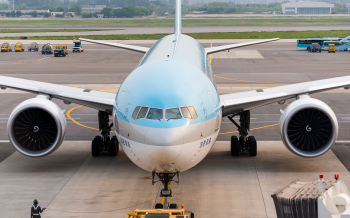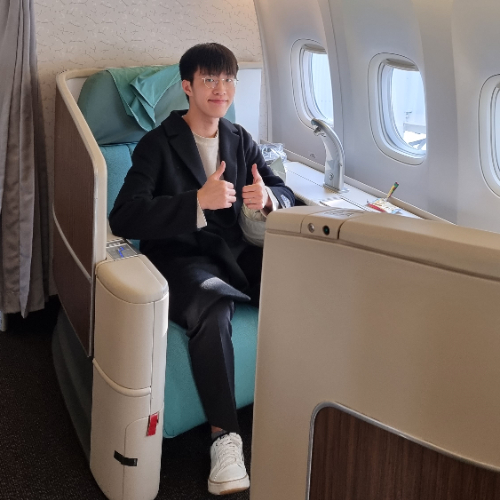Korean Air has introduced a new type of aircraft to its fleet: the Boeing 787-10 Dreamliner. The flag carrier took delivery of the new aircraft, registered HL8515, just five days ago, and the Dreamliner made its first commercial flight today bound for Tokyo.
This new addition makes Korean Air the operator of all Dreamliner variants (although the sole 787-8 is operated as a VIP charter for Samsung).
A New Aircraft Type
Korean Air has quite a diverse fleet, from Boeing 737s and A321s, to Boeing 747s and A380s. The airline also has 13 Boeing 787-9s, which entered service in 2017. The 787-10 variant is yet another addition to diversify its fleet further.
This stretched Dreamliner jet was introduced to replace the aging A330-300s flying for the airline. Korean Air currently operates 19 A330-300s, with 272~284 seats. Six of these aircraft were HGW (High Gross Weight) variants, with additional orders made in the late 2000s as the Dreamliner project had been delayed significantly during development.

Most of the A330s are over 20 years old, so the longer Dreamliner variants are to replace these older aircraft, considerably reducing the average fleet age.
The aircraft order was initially believed to have not opted for the bunker rest area. However, after today's maiden flight, it was confirmed that the aircraft had a bunker area. This implies that the Boeing 787-10 could also fly popular long-haul routes that are currently operated with the Boeing 777 and Boeing 787-9.
A Brand-New Cabin
Korean Air is known for its sky-blue exteriors and the same-colored interiors that match its shell. The newest long-haul business class used Apex Suites, decorated in sky-blue with veneered wood. These seats are named "Prestige Suites" by Korean Air. Apex Suites is also used by Japan Airlines, Gulf Air and Oman Air.
However, the new Dreamliner sports Collins Aerospace Horizon Premier seats, also found in the new business class cabin in select Turkish Airlines' A350s (these A350s were intended for Aeroflot, but untaken for obvious reasons). These seats are designated as "Prestige Suites 2.0" by Korean Air.
It also seems that Korean Air is going for a new cabin theme, as there is no blue anywhere to be seen. The A321neos also feature a brown-themed premium cabin, suggesting that the new design for premium cabins are to be more brownish.
This marks the first time Korean Air has used a staggered configuration in business class, and it has less than 6 seat six per row for widebody aircraft. For example, here is a seat map for the Boeing 777-200ER and A330-300, compared to the new Dreamliner.
The economy class seats are Safran Z400s, the same seats used in their brand-new A321neos.
First Commercial Service
The new aircraft flew its first commercial service as KE703 bound for Tokyo today. Apparently, no ceremony or event took place. The flight took off from Incheon International Airport (ICN) at 10:31 local time (KST), landing at Tokyo Narita International Airport (NRT) at 12:25 (same time zone).
After the flight, HL8515 returned to Incheon, operating the return flight, KE704. The aircraft touched down in its new home at 16:22, and has been on the ground until time of writing.
Another Type to be Added Soon
This is not the only new aircraft type that Korean Air would be receiving this year. As talks about the merger with Asiana Airlines are advancing, Korean Air announced its intentions to operate the Airbus A350, which is currently the flagship aircraft for Asiana.
In May, news reports stated that Asiana would delay its A350 deliveries, instead transferring new aircraft to Korean Air. A new A350 now owned by Korean Air is currently undergoing ground testing at Toulouse, registered as HL8597 (test registration F-WZFU). These new A350s are to be delivered this year around November.
It is unknown if the A350s would use Prestige Suites 2.0, or use Asiana business class hard products.
Maldivian Airlines Introduces First-Ever Widebody Aircraft, Plans New China Flights » Could You Survive a Plane Crash? The Unlikely Science of Plane Crash Survival » Bomb Threat Cancels Air New Zealand Flight, Delays Passengers »
Comments (0)
Add Your Comment
SHARE
TAGS
NEWS Dreamliner787-10BoeingAirbusA350CollinsApexSuitesPresitgeKorean AirAsianaSeoulIncheonTokyoNaritaRECENTLY PUBLISHED
 Could You Survive a Plane Crash? The Unlikely Science of Plane Crash Survival
With air travel consistently being heralded as the safest form of public transport, most of us do not board a plane pondering our chances of survival in the event of a crash. But, is it possible to survive one?
INFORMATIONAL
READ MORE »
Could You Survive a Plane Crash? The Unlikely Science of Plane Crash Survival
With air travel consistently being heralded as the safest form of public transport, most of us do not board a plane pondering our chances of survival in the event of a crash. But, is it possible to survive one?
INFORMATIONAL
READ MORE »
 Maldivian Airlines Introduces First-Ever Widebody Aircraft, Plans New China Flights
Maldivian, the government-owned national airline of the Maldives, has just welcomed its first-ever wide body aircraft: the Airbus A330-200. With the new aircraft, the carrier also plans brand-new long haul international flights to China.
NEWS
READ MORE »
Maldivian Airlines Introduces First-Ever Widebody Aircraft, Plans New China Flights
Maldivian, the government-owned national airline of the Maldives, has just welcomed its first-ever wide body aircraft: the Airbus A330-200. With the new aircraft, the carrier also plans brand-new long haul international flights to China.
NEWS
READ MORE »
 Thousands of Flights Impacted as Winter Storm Blair Hits U.S.
Winter Storm Blair has unleashed a huge blast of snow, ice, and freezing temperatures across the Central and Eastern United States.
As of Sunday afternoon, over 6,700 flights and counting have been disrupted. This includes cancelations and significant delays leaving passengers scrambling to change flights and adjust travel plans.
NEWS
READ MORE »
Thousands of Flights Impacted as Winter Storm Blair Hits U.S.
Winter Storm Blair has unleashed a huge blast of snow, ice, and freezing temperatures across the Central and Eastern United States.
As of Sunday afternoon, over 6,700 flights and counting have been disrupted. This includes cancelations and significant delays leaving passengers scrambling to change flights and adjust travel plans.
NEWS
READ MORE »





